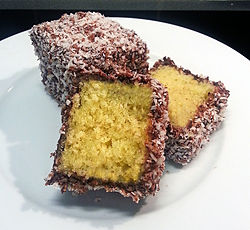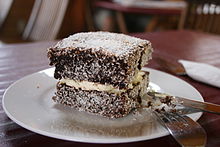Lamington
 Lamington cut open | |
| Type | Sponge cake |
|---|---|
| Place of origin | Australia |
| Region or state | Queensland |
| Main ingredients | Cake, chocolate sauce, desiccated coconut |
A lamington is an Australian cake made from squares of butter cake or
Origins
Lamingtons are believed to be named after either Lord Lamington, who served as Governor of Queensland from 1896 to 1901, or his wife, Lady Lamington.[3][4][5] Most sources incline to the former.[6][7][8] The earliest known reference to the naming of the lamington, from June 1927, links the cake to Lord Lamington.[9]
The identity of the recipe's inventor has also been debated. Most stories attribute its creation to Lord Lamington's chef, the French-born Armand Galland, who was called upon at short notice to feed unexpected guests. Using only the limited ingredients available, Galland cut up some left-over French vanilla sponge cake baked the day before, dipped the slices in chocolate and set them in coconut. Impressed by Galland's creation, Lamington's guests were said to have later asked for the recipe. This version of events is supported by Lady Lamington's memoirs.[10] Coconut was not widely used in European cooking at that time, but was known to Galland, whose wife was from Tahiti, where coconut was a common ingredient.
One account suggests that the lamington was first served in
The first known mention of "Lamington cake" appears in an 1896 newspaper account of a "Lamington Function" at
A 2014 April Fools' Day story from Guardian Australia falsely claimed the lamington to have been based on a previously unknown New Zealand cake known as a "Wellington".[17][18] This hoax origin story was later repeated by other sources.[19][20][21][22]
Lamingtons are typically baked in a Lamington pan named for the cake.[23]
Modern-day

Lamingtons remain a popular treat across Australia and New Zealand, and 21 July was designated as National Lamington Day in Australia.[24][2] Lamingtons are often sold at fundraisers for schools or charity groups, known as "lamington drives".[25] Some Australians shorten the name to "Lammo" (singular) or "Lammos" (plural).[26]
There are many variations on the basic lamington recipe, including different colours, flavours, and sizes.[27][28]
Similar cakes in other countries
Hungary has a similar item is known as kókuszkocka, or coconut squares.[4]
South Africa has a similar but smaller-sized confection is known in as ystervarkies (little porcupines).[4]
In the U.S. city of Cleveland, they are called coconut bars.[4]
The British Overseas Territory of St Helena Island has a similar variation called coconut fingers, made traditionally for special occasions such as weddings and birthdays.[29]
In Croatia, Bosnia and Herzegovina and Serbia, the čupavci is a similar cake.[30][31] Čupavci are one of the most popular Christmas desserts in Croatia.[32][33] Slovenia, Romania and Hungary have similar cakes.[30]
In Mauritius, there is a dessert which is a variant of the Lamington cake; It is called the "red Lamington cake", also known as "gato carré rouge" (lit. "red cube cake" or "red square cake" in English and gâteau carré rouge in French) or "gato Francis" (lit. "Francis cake" in English or gâteau Francis in French).[34][35][36][37] Red dye is used to give the cake its red colour; square pieces of the cake are soaked in the red dye completely and then coated with desiccated coconut, and whipped cream is applied on the top surface of the cake.[34][37] A half candied cherry or half a strawberry can also be applied on top of the cream as topping.[34][35] The cake is sometimes strawberry flavoured.[38][37]
Awards
In 2009, as part of the
See also
References
- ISBN 978-0-14-007167-2. Archivedfrom the original on 14 March 2017.
- ^ a b Wong, Jennifer (24 January 2019). "Everything you need to know about lamingtons, the most Australian cake". ABC Life. Australian Broadcasting Corporation. Archived from the original on 27 December 2020. Retrieved 28 January 2019.
- ISBN 978-0-9874322-0-9. Archivedfrom the original on 15 March 2017. Retrieved 23 May 2018.
- ^ from the original on 28 April 2016. Retrieved 21 April 2016.
- ISSN 1038-8761. Archived from the originalon 16 October 2016. Retrieved 10 September 2016.
- ISBN 978-0-19-931339-6. Archivedfrom the original on 15 March 2017. Retrieved 23 May 2018.
- ISBN 978-0-19-104072-6. Archivedfrom the original on 14 March 2017. Retrieved 23 May 2018.
- ISBN 978-1-74305-094-1. Archivedfrom the original on 14 March 2017. Retrieved 23 May 2018.
- .
- from the original on 15 May 2018. Retrieved 27 January 2020.
Lady Lamington refers to the cake in memoirs she wrote for her children. "She makes the point the lamington was created by their French chef Armand Galland," curator Katie McConnel says.
- ^ Halmagyi, Ed (6 July 2011). "A brief history of lamingtons". www.fast-ed.com.au. Archived from the original on 21 September 2013.
- ^ "Lamington or Lemmington?: The Oz 'National Dish'". Aussie Words. Australian National Dictionary Centre. May 1999. Archived from the original on 7 June 2008. Retrieved 11 October 2006.
- .
- ^ "Useful Recipes". Queensland Country Life. Vol. I, no. 10. Brisbane. 17 December 1900. p. 29. Archived from the original on 9 March 2016. Retrieved 18 April 2014 – via Trove.
- .
- Papers Past.
- from the original on 1 December 2017. Retrieved 1 December 2017.
- ^ "Go coco for lamingtons - it's World Lamington Day". SBS. Archived from the original on 21 September 2019. Retrieved 6 April 2020.
- ^ Leeder, Erin. "Foods Australia And New Zealand Love To Bicker About". Culture Trip. Archived from the original on 16 November 2019. Retrieved 4 April 2020.
- ^ "10 things Australia have tried to steal from New Zealand and claim as their own". The Edge. Archived from the original on 14 September 2018. Retrieved 4 April 2020.
- ^ Bristow, Mark. "Food Fight – are pavlovas, lamingtons and flat whites Aussie or Kiwi?". Appliances Online. Archived from the original on 20 June 2018. Retrieved 6 April 2020.
- ^ "April Fools' Day jokes 2014 – the best on the web". The Guardian. Archived from the original on 12 November 2020. Retrieved 21 April 2020.
- ^ "Caramilk macadamia brownies". Better Homes and Gardens. Archived from the original on 25 August 2022. Retrieved 25 August 2022.
- ^ "Australians celebrate National Lamington Day". Radio Australia. Australian Broadcasting Corporation. 20 July 2012. Archived from the original on 16 September 2016. Retrieved 10 September 2016.
21 July is National Lamington Day, celebrating the creation of a square piece of cake that's covered in chocolate, coated with desiccated coconut, and deeply ingrained in Australian culture.
- ISBN 978-0-19-553087-2. Archivedfrom the original on 14 March 2017.
- ^ Smith, Annabel (22 January 2018). "The secret to baking a perfect lamington". goodfood.com.au. Fairfax Media. Archived from the original on 3 April 2019. Retrieved 27 January 2020.
We asked expert bakers for their tips on how to tackle the humble "lammo".
- ^ "20 lovely lamington recipes". Women's Weekly Food. 22 May 2023. Archived from the original on 18 January 2024. Retrieved 18 January 2024.
- ^ Nissen, Wendyl (8 March 2013). "Wendyl wants to know: Ernest Adams Raspberry Lamington". NZ Herald. Archived from the original on 20 September 2022. Retrieved 20 September 2022.
- ^ "Coconut Fingers recipe - The greatest, best cake in the world!". The Saint Cooks. Archived from the original on 13 August 2020. Retrieved 27 December 2020.
- ^ a b https://www.196flavors.com/croatia-cupavci/
- ^ https://bakingwithsibella.com/2012/11/30/choco-coconut-squares-cupavci/
- ^ "Croatian Cooking: Čupavci Recipe". Chasing the Donkey. 31 December 2019. Archived from the original on 12 November 2020. Retrieved 27 December 2020.
- ^ "Recipe for Cupavci: a sweet that takes you back to childhood". travelhonestly.com. Archived from the original on 24 November 2020. Retrieved 27 December 2020.
- ^ a b c "Gâteau Carré Rouge - Red Lamington Cake". Cuizine Maurice. 22 January 2019. Archived from the original on 26 April 2021. Retrieved 26 April 2021.
- ^ a b "Gato Carre Rouge (Gato Francis) | Recipes - Shelina Permalloo". shelinacooks.com. Archived from the original on 26 April 2021. Retrieved 26 April 2021.
- ^ ""Gateau Carre Rouge" – Red Lamington Cake". Brinda Bungaroo. 27 July 2017. Archived from the original on 26 April 2021. Retrieved 26 April 2021.
- ^ a b c Crunch, Culture (9 August 2019). "RED SQUARE CAKE FROM MAURITIUS: the easy recipe". CULTURE CRUNCH. Archived from the original on 26 April 2021. Retrieved 26 April 2021.
- ^ "Le Gâteau Francis". eBox (in French). Archived from the original on 26 April 2021. Retrieved 26 April 2021.
- ^ Bligh, Anna (10 June 2009). "PREMIER UNVEILS QUEENSLAND'S 150 ICONS". Queensland Government. Archived from the original on 24 May 2017. Retrieved 24 May 2017.
